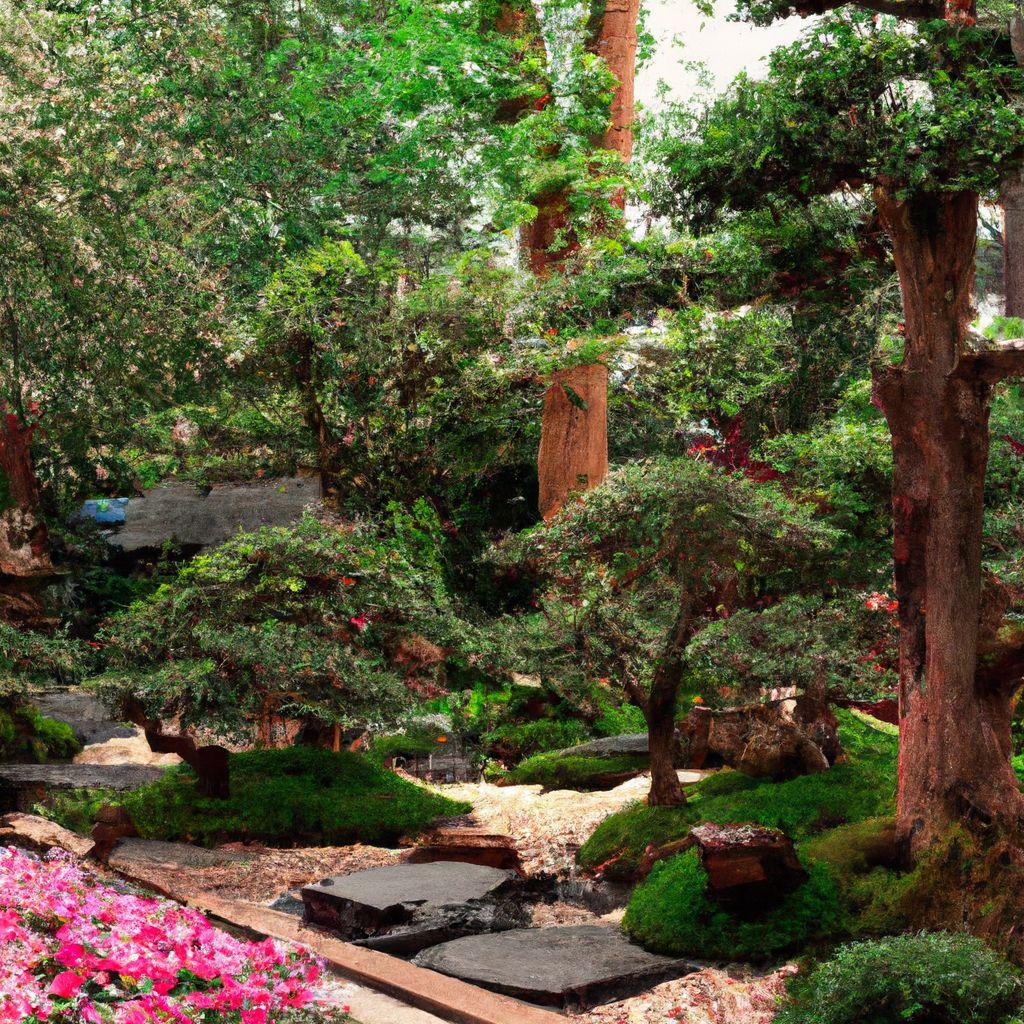Key Takeaways:
- The art of growing and maintaining bonsai trees requires careful attention and maintenance to create a beautiful bonsai garden.
- Design considerations for a well-designed bonsai garden include using shade-cloth systems, displaying important trees on vertical poles, and using appropriate materials for poles.
- When building and designing bonsai benches, it is important to consider durability and functionality, explore different bench designs, and choose appropriate factors in bench design.
- Choosing suitable bonsai species based on climate conditions, exploring popular choices for bonsai trees, and understanding different bonsai styles and their characteristics are important in bonsai garden design.
- Maintenance and care for bonsai gardens involve understanding light and watering requirements, implementing repotting and shaping techniques, pruning and limiting branches for sunlight penetration, and choosing balanced fertilizer and proper feeding.
- Incorporating bonsai trees into landscape design can be done by making them the centerpiece, considering overall design and tree health, and complementing them with rocks and water features.
- Enhancing bonsai landscaping can be achieved by adding additional elements like water features and lighting, considering outdoor furniture for a peaceful oasis, experimenting with different arrangements and styles, and displaying significant trees on poles for better visibility.
- Recap of the importance and beauty of bonsai gardens and final tips for successful bonsai garden design and maintenance conclude the key takeaways.
Introduction to Bonsai Garden Design
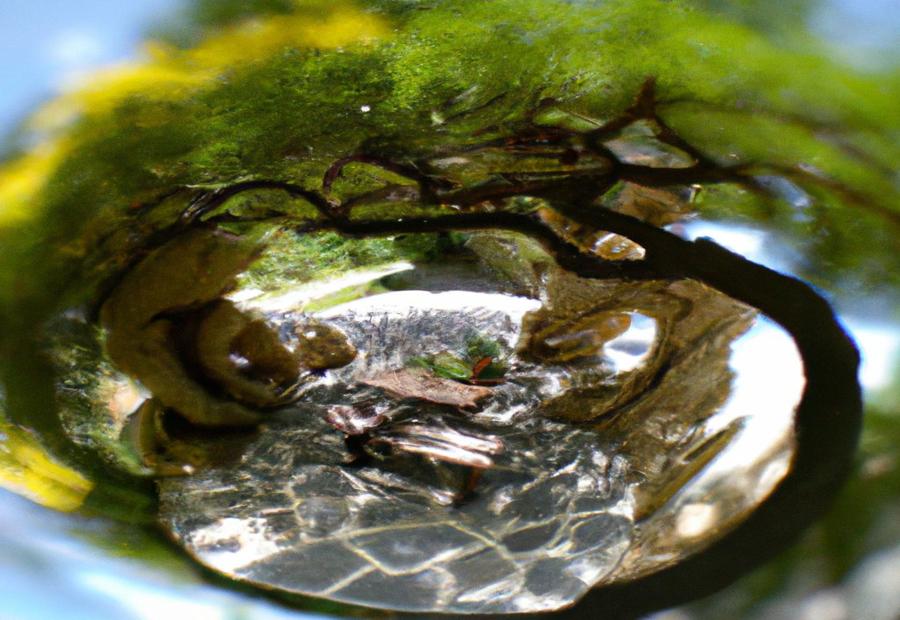
Photo Credits: Gardeninggurus.Org by Ralph Nguyen
Bonsai garden design is a fascinating world that encompasses the art of growing and maintaining bonsai trees. Discover the intricacies and meticulous care involved in creating these miniature yet captivating living sculptures. Delve into the importance of giving careful attention and maintenance to these delicate creations, as we explore the secrets behind cultivating and nurturing the perfect bonsai garden.
The art of growing and maintaining bonsai trees
Bonsai trees require a deep understanding of their growth patterns – each species needing unique amounts of sunlight, water and temperature. Study these patterns to ensure proper care and development.
Pruning is essential to maintain a balanced canopy and stop overcrowding. Trim branches to shape the tree and promote new growth.
Regular maintenance routines are vital – watering, fertilizing and pest control. Care and attention to detail is key.
Aesthetics are important too – trunk movement, branch structure, foliage density and balance all need consideration. Skilled bonsai artists take this into account.
Placement is also essential – shade-cloths, poles and benches can be used to enhance the overall presentation. Materials for these items affect design and function.
The secret to successful bonsai is finding the right balance – enough attention to keep them alive, not too much.
The importance of careful attention and maintenance
The importance of careful attention and maintenance in bonsai garden design is vital. Regular care and attention is needed for bonsai trees to thrive and keep their desired appearance. This includes proper watering, sunlight, pruning, repotting, and balanced fertilizer. Neglecting these can result in stunted growth, disease, or even death.
Bonsai trees need individualized care. This means understanding light and watering requirements for each tree, when to repot or shape them, and regular pruning to limit branch growth. Balanced fertilizer and proper feeding also promote strong root development and growth.
Maintaining a bonsai garden requires ongoing commitment. This involves regular maintenance tasks and evaluating the health and progress of each tree. Adjustments to watering schedules or placement may be necessary. By being attentive to each tree’s needs and making changes over time, bonsai enthusiasts can ensure the long-term health and beauty of their gardens.
The history behind the importance of careful attention and maintenance is valuable. Bonsai has a long cultural heritage dating back to ancient China. It was passed down through generations, emphasizing the significance of nurturing and tending to bonsai trees to preserve their beauty and uphold their artistic value.
Creating a Bonsai Garden
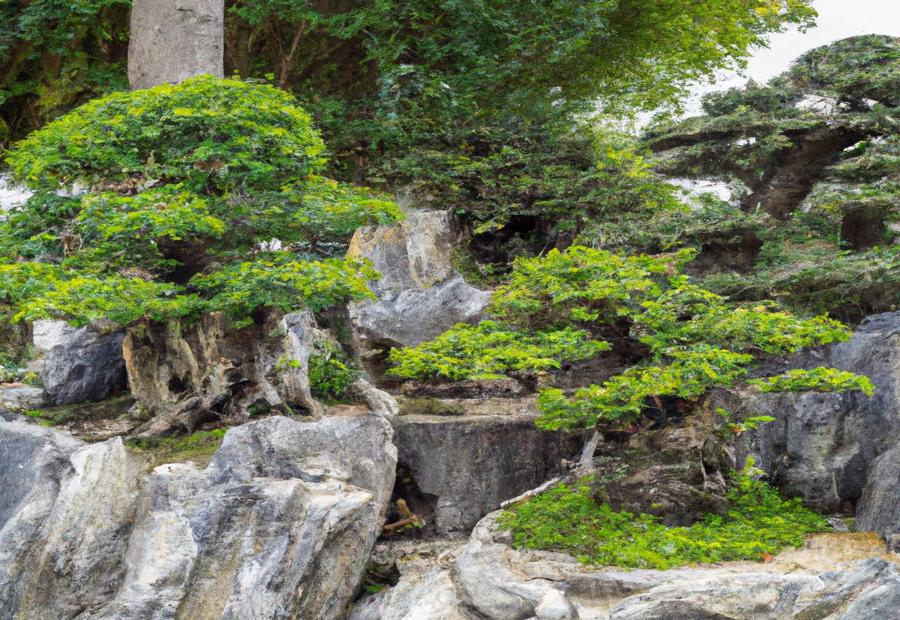
Photo Credits: Gardeninggurus.Org by Larry Jones
A well-designed bonsai garden requires careful consideration of design elements, such as shade-cloth systems, vertical poles for tree display, and the selection of materials for poles. Discover the key aspects of creating a captivating bonsai garden and explore how these design considerations can elevate the beauty and impact of your own miniature tree landscapes.
Design considerations for a well-designed Bonsai garden
For a successful Bonsai garden, many factors need to be taken into account. Picking the spot is key, as it should get just the right amount of sunlight and be sheltered from strong gusts. Additionally, the design should involve multiple levels and paths for visual appeal and easy navigation. Plus, suitable plants and trees that go well together in terms of size, color, and texture are crucial for a consistent look.
Location:
A great Bonsai garden begins by finding a spot that meets the needs of bonsai trees. This includes providing enough sunlight and protection from storms and frost.
Layout:
For a captivating look, put thought into the garden’s layout and positioning of the bonsai trees. Creating different levels with rocks or low walls gives the garden more depth, while pathways make it easier to explore.
Plant selection:
The plants and trees should blend in terms of height, color of foliage, and texture – this helps create a harmonious design. Also, think of seasonal changes to keep the garden interesting all year round.
Bonus: To spruce up the garden, add water features and decorative accents, like statues.
Pro Tip: Incorporate rocks and water features to give the Bonsai garden a tranquil atmosphere.
Using shade-cloth systems to provide varying amounts of shadow
Shade-cloth systems are a great way to give your bonsai garden varying levels of shadow. These systems are designed to control the amount of sun that reaches the trees, allowing for perfect growth and development. Using shade cloths is an important factor in bonsai garden design. It lets you flexibly manage the amount of shade and sun exposure, which significantly affects the trees’ health and look.
- Step 1: Choosing the right shade cloth – The first step when using shade-cloth systems is to select the correct material. Commonly used materials are woven polyethylene or polyester. They provide different levels of shade depending on their density. You need to consider the climate, tree species and desired shade when picking a shade cloth.
- Step 2: Installing the shade-cloth system – After choosing the right shade cloth, it needs to be set up correctly in the bonsai garden. This includes securing the cloth to a supporting framework, such as poles or overhead wires. The installation should make sure there’s the correct tension and coverage for consistent shading in the garden.
- Step 3: Monitoring and adjusting shading levels – After installing the shade-cloth system, it’s essential to monitor and adjust the shade levels according to the bonsai trees’ needs. This can be done by manually changing the position or density of the shade cloth or using automated systems that respond to sunlight intensity changes. By managing shading levels carefully, bonsai enthusiasts can create the perfect environment for their trees.
Shade-cloth systems also give other benefits for a bonsai garden. They can shield delicate trees from extreme weather, lower water evaporation from containers, stop strong wind damage, and create a beautiful backdrop for the bonsai display. When using shade-cloth systems, you must think about the tree species’ needs, regional climate conditions, and the garden’s desired aesthetics.
Jane, a bonsai gardener, learnt this lesson first-hand. She had difficulty keeping her bonsai trees healthy amidst her region’s unpredictable weather. After adding shade cloths to her garden, Jane saw huge improvements in the trees’ health and growth. The shade-cloth system allowed her to give the trees the exact amount of shadow. It shielded them from scorching sun during summer and still enabled enough light for photosynthesis. Because of the good results, Jane continued to experiment with different shading levels and materials to get the best results.
Displaying important trees on vertical poles
- Vertical pole displays offer a unique way to feature bonsai trees in a garden. They provide depth, height, and visual interest.
- Choose poles made from durable materials like wood or metal. It is as important as picking the right joke at a funeral.
- Position the poles strategically to showcase the trees and create visual interest. Determine the height and spacing of the poles to enhance the garden design.
- Use specialized hooks, wires, or other fastening methods to attach the trees securely. Make sure the tree is balanced on the pole.
- To make the trees more noticeable, use appropriate lighting techniques, especially during nighttime or low light conditions.
- In conclusion, display bonsai trees on vertical poles for a captivating garden design. Choose sturdy poles, place them strategically, attach the trees securely, and use proper lighting. This will create an aesthetically pleasing and visually striking display.
Materials commonly used for poles
Materials used for poles in bonsai gardens vary. Wood, metal, bamboo, concrete and PVC are all options. Factors like durability, aesthetics and availability are important when deciding. Hardwoods like oak and cedar are visually pleasing and blend in with garden landscaping. Metal poles, like stainless steel or iron, offer strength and durability for heavier bonsai trees. Bamboo is flexible, allowing for creative designs, and adding elegance. Concrete is stable and long-lasting, but not as visually appealing. PVC pipes are lightweight and cost-effective. They can be painted or textured to look like wood or bamboo.
Bonsai enthusiasts should consider the advantages of each material to pick the best one for their needs. Structural support and aesthetic appeal are both key.
Building and Designing Bonsai Benches
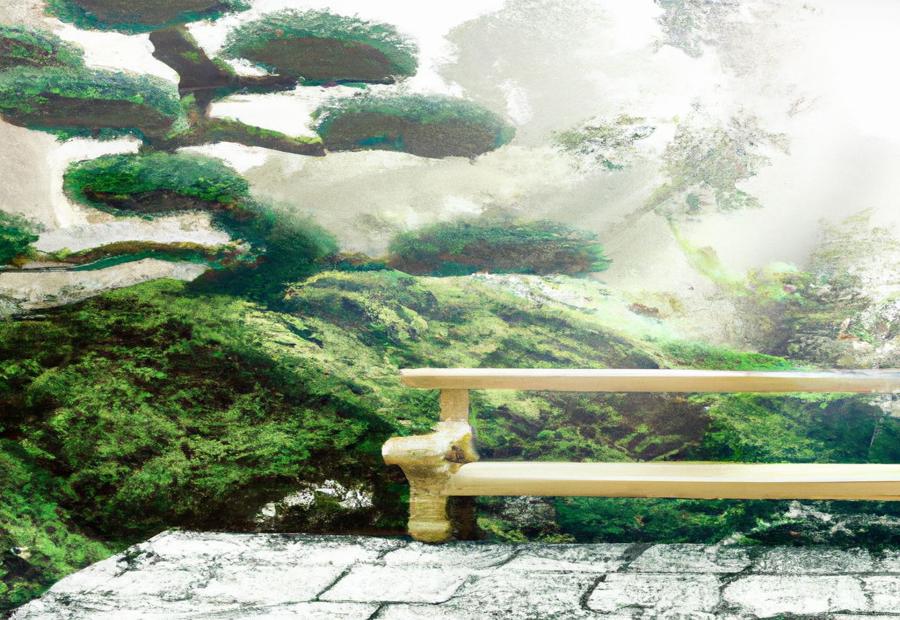
Photo Credits: Gardeninggurus.Org by Mason Jackson
Building and designing bonsai benches can be a challenging task, requiring both durability and functionality. In this section, we will explore examples of benches specifically designed for bonsai trees. We will also delve into key factors to consider when crafting a bench to ensure it complements the beauty and uniqueness of your bonsai garden. Get ready to discover practical insights and inspiration for creating the perfect bonsai bench.
The challenge of building a durable and functional bench
Constructing a bench for bonsai trees is a challenge. It must be strong enough to support the trees. Plus, it must stand up to outdoor conditions and resist decay.
When designing the bench, you need to consider many things. Width and depth should be big enough to fit multiple trees. The height should be comfortable for tending the trees. Durable materials, like metals or hardwoods, will ensure the bench lasts. It must have strong legs or support systems to hold the weight of the trees. Also, drainage systems should be in place, so water doesn’t damage the trees or the bench. Lastly, it should be easy to access each tree for maintenance.
Design considerations, stability, durability, drainage, and accessibility are all factors to consider when constructing a bonsai bench. With these, you can ensure your bonsai trees have a safe and secure spot, while still looking beautiful.
When I built my own bonsai garden, I had to create a suitable bench for my trees. After looking into designs and taking into account factors like durability and accessibility, I constructed the perfect bench. It is the perfect spot to show and take care of my bonsai treasures. This bench is the perfect mix of function and beauty for a peaceful space for bonsai trees.
Examples of benches for Bonsai trees
Bonsai gardens are a peaceful paradise of natural beauty. To show off these majestic bonsai trees, expertly crafted benches are key. They add elegance and serve as platforms to display the bonsai trees. There are many bench examples tailored to meet various needs.
One design features multiple levels or platforms. This way, gardeners can display bonsai trees of different heights, creating a stunning arrangement. Another option is slatted benches with a top surface of wooden slats and gaps in between. This design increases air circulation to the delicate roots, helping the trees grow.
For a unique look, floating benches create an illusion that the bonsai trees are floating above the ground. Acrylic or glass supports are used for this effect. Plus, custom benches can be crafted from wood, metal, and stone. These can even include drawers or shelves.
These bench designs are both practical and beautiful. Factors like space, functionality, and personal style determine the best fit for a bonsai garden. Creativity is also encouraged. Gardeners have experimented with different materials, shapes, sizes, and aesthetics for a unique bench design. This type of design complements the overall bonsai garden design, elevating the beauty and presentation of each tree.
Key factors to consider in bench design
Designing a bench for bonsai gardens requires considering a multitude of factors:
- durability and functionality
- size and dimensions
- material
- weight-bearing capacity
- spacing between bonsai trees
- aesthetic integration with the overall garden design
Furthermore, adjustable features, ergonomics, and accessibility should also be considered for additional functionality.
When selecting materials, choose those that are weather-resistant and durable. Adjustable features, such as movable shelves and elevation options, can be incorporated to provide versatility. Storage compartments within the bench can also help keep tools and supplies organized.
By carefully considering these factors, one can create a functional and aesthetically pleasing bench that enhances the beauty of a bonsai garden. Just like a perfect date, our bonsai trees will always leave you wanting more!
Choosing Bonsai Species and Styling
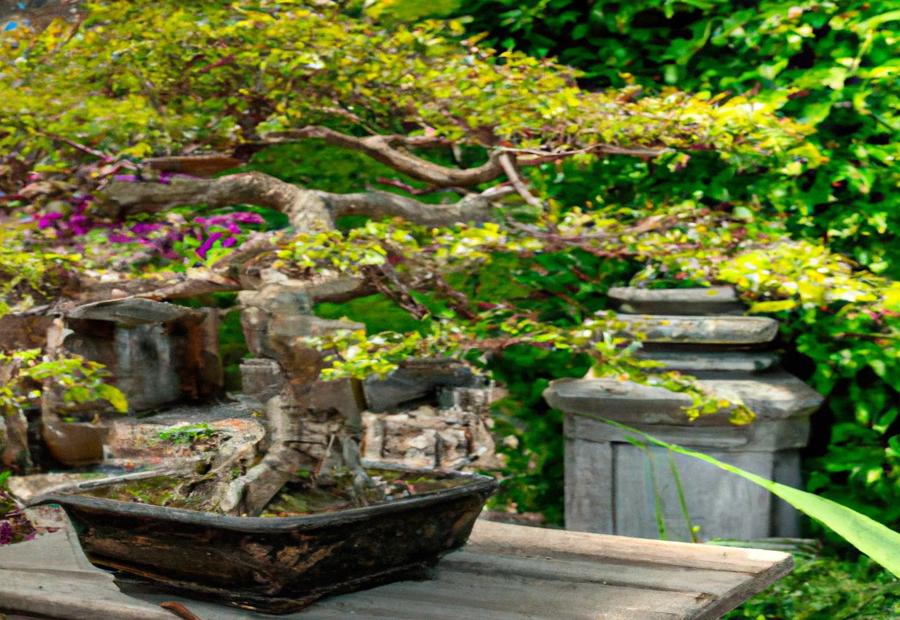
Photo Credits: Gardeninggurus.Org by Roy Lewis
When it comes to creating a beautiful bonsai garden, selecting the right species and styling techniques are key. Discover the suitable bonsai species for various climate conditions, explore popular choices for bonsai trees, and learn about the different bonsai styles and their unique characteristics. Whether you’re a seasoned bonsai enthusiast or a beginner looking to delve into this ancient art form, this section will provide invaluable insights into designing your very own bonsai garden.
Suitable species for different climate conditions
Selecting bonsai trees for your garden? Consider the local climate!
Juniperus chinensis and Pinus thunbergii are great for cooler climes, while Ficus microcarpa and Podocarpus macrophyllus are ideal for warmer, higher-humidity areas.
Deciduous types like Acer palmatum and Ulmus parvifolia will do well in temperate regions. Conifers like Thuja occidentalis and Taxus cuspidata can adapt to many climates.
Crassula ovata and Portulacaria afra are perfect for arid, dry environments.
Lastly, Myriophyllum spicatum and Ceratophyllum demersum are great for ponds or water features.
By selecting the right bonsai species for your climate, you’ll ensure your trees get proper care and look fabulous!
Popular choices for bonsai trees
Bonsai trees are a popular pick for gardens, thanks to their special features and styling versatility. These trees have been grown for centuries, and their attraction comes from their mini versions of full-sized tree species. Certain types of trees work well for bonsai artistry and aesthetics, like Juniper, Pine, Maple, Ficus, Spruce, and Cherry Blossom. Azalea, Elm, Cedar, and Wisteria are less common, yet still contribute to the allure of a bonsai garden. Popular choices depend on personal preference, desired styles, climate, and caretaking. Ultimately, there’s no definitive list, but these types are among the most desired by bonsai enthusiasts.
Bonsai styles are like the Spice Girls: each one has its own unique personality, and you’ll definitely want to try them all!
Different bonsai styles and their characteristics
Bonsai has been a part of Japan for centuries. Different styles of bonsai, representing various artistic interpretations and cultural influences, express creativity and a sense of balance and harmony.
The Formal Upright style, also known as Chokkan, is characterized by a straight trunk with gradually decreasing branch sizes. This style reflects strength and stability.
The Informal Upright style or Moyogi, presents a more natural growth pattern. Branches are irregularly spaced and have varying lengths, creating a more casual look.
The Cascade style, or Kengi, replicates trees growing on cliffs or steep slopes. The trunk cascades below the pot’s edge, creating a dramatic effect. This style shows grace and movement.
Other bonsai styles include Windswept (Fukinagashi) and Broom (Hokidachi) – branches blown by strong winds, and a straight trunk with branches radiating in all directions.
The elements of these styles give a unique experience to the gardener, demonstrating the importance of finding balance and harmony.
Maintenance and Care for Bonsai Gardens
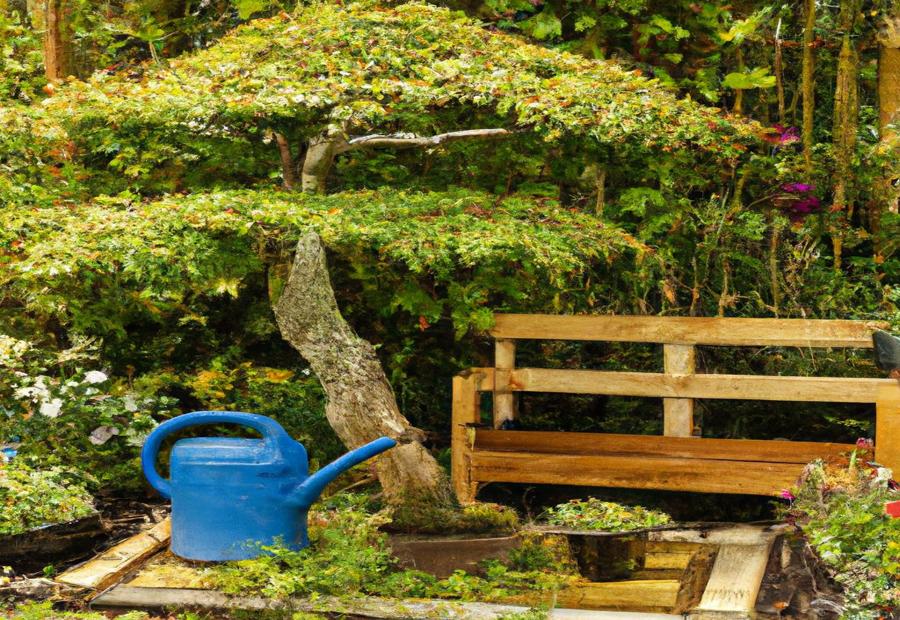
Photo Credits: Gardeninggurus.Org by Joseph Rivera
Maintaining and caring for bonsai gardens is of utmost importance to ensure the health and beauty of these miniature trees. In this section, we will delve into the essential aspects of maintenance and care for bonsai gardens. From understanding the specific light and watering requirements of bonsai trees to mastering repotting and shaping techniques, we will explore various practices that contribute to the vitality and longevity of these living works of art. Additionally, we will touch upon pruning and branch limitation techniques, as well as the importance of choosing balanced fertilizers for optimal nourishment.
Light and watering requirements for bonsai trees
Bonsai trees need special light and watering to stay healthy and grow. Knowing and following these needs will guarantee the success of any bonsai garden.
Light requirements depend on the species. Some prefer full sun, others like partial shade. Research each tree’s light preferences for the perfect amount of sun.
Watering is essential. Too much or too little can cause problems. Water well when the soil is dry but don’t keep it constantly moist – this can lead to root rot.
How often to water depends on climate, time of year, and tree needs. Make a watering plan that takes all these into account.
Misting or humidity trays around the foliage can help in dry climates or when humidity is low.
Remember that different species have unique needs. They may need more light or water than others, so consider each tree’s specific needs.
In conclusion, light and watering are key for bonsai growth and health. By taking into account variables like sunlight, watering frequency, and species requirements, bonsai gardeners can create an environment that ensures their little trees thrive. Don’t miss out!
Repotting and shaping techniques
-
- Assessing Pot Bound Conditions:
Step 1: Take out the bonsai tree from the pot. Look for tangled roots, which shows a pot-bound condition. Gently loosen them.
-
- Selecting the New Pot & Soil Mix:
Step 2: Pick a pot that’s slightly bigger than the existing one. Make sure it has good drainage holes. Prepare a soil mix that allows for air circulation.
-
- Repotting & Shaping:
Step 3: Put a layer of soil in the pot. Place the tree in the pot at the right angle. Surround with soil and press down to secure the roots. Prune back any long branches to get your desired shape. Consider the species and growth patterns when repotting and shaping.
Other aspects related to bonsai gardening such as water, pruning, fertilizer, and landscape design also help maintain healthy bonsai gardens. Pruning and limiting branches is like giving your bonsai a stylish haircut.
Pruning and limiting branches for better sunlight penetration
Pruning and limiting branches for better sunlight penetration in bonsai gardens is key. To do this, trim and remove extra branches. This will let the sunlight reach the bottom of the tree. Doing so will help with healthy growth and development.
For successful pruning and branch limitation:
- Assess the tree. Look at the structure and see if any branches are overcrowding or blocking sunlight. You may need to cut some branches or thin out areas.
- Selective pruning. Use sharp, clean pruning shears to cut the branches. Start with dead or damaged branches. Cut any crossing or horizontal branches blocking sunlight too.
- Create a shape. Prune branches evenly to make a balanced shape. Maximize sunlight exposure as you go.
- Regular maintenance. Pruning isn’t a one-time job. Check and prune regularly to make sure the tree gets enough sunlight.
Pruning offers other benefits too. It can make your bonsai trees look better by creating refined shapes and focal points. Plus, it helps air circulation and prevents diseases caused by overcrowding.
Choosing balanced fertilizer and proper feeding
Finding the right fertilizer balance and feeding properly is vital for bonsai tree health and growth. The correct fertilizer selection and application can give these little trees the nutrients they need to flourish. And proper feeding makes sure the trees get enough nourishment to match their special needs.
- Pick a balanced fertilizer that fits the specific nutrition needs of different bonsai species.
- Make sure the fertilizer contains the necessary macronutrients, like nitrogen, phosphorus and potassium.
- Organic fertilizers or slow-release pellets release nutrients over time.
- Be careful not to over-fertilize as this can cause too much growth or root damage.
- Observe when and how often to feed, adjusting according to tree growth stage and environment.
- Monitor the tree’s reaction to the fertilizer and change if needed for optimal growth.
Moreover, each bonsai tree has its own fertilizer needs. Some may need frequent feeding while others may be sensitive to certain fertilizers. It’s key for bonsai lovers to do research and understand their trees’ particular requirements to choose the most suitable balanced fertilizer and feed properly.
By keeping these points in mind, bonsai enthusiasts can make sure their trees get essential nutrients in a controlled and balanced way. This drives healthy growth, lively foliage and overall good health for these beautiful mini trees.
Adding bonsai trees to landscape design adds a classy and peaceful feel, like tiny oases in a world of sprawling scenes.
Incorporating Bonsai Trees into Landscape Design
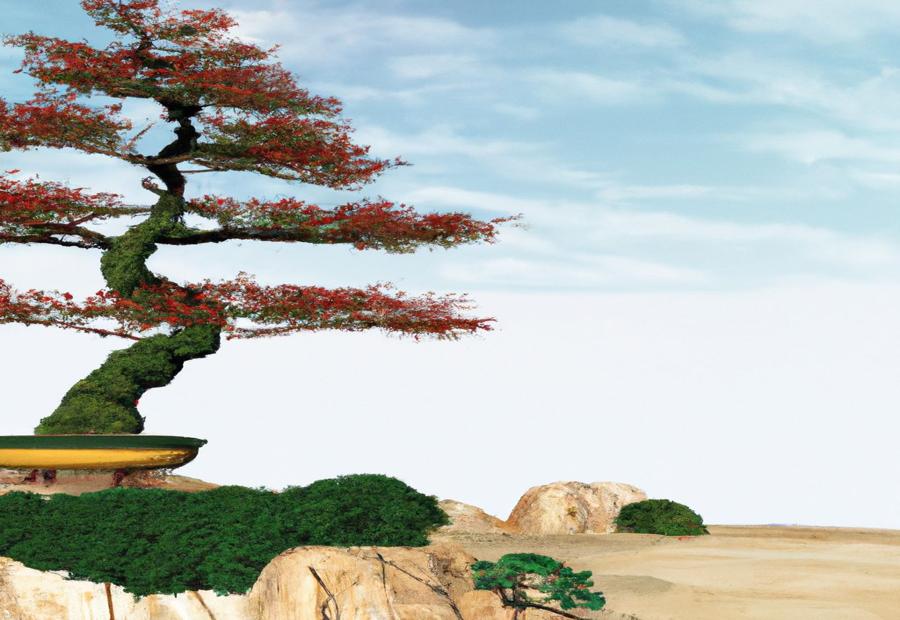
Photo Credits: Gardeninggurus.Org by Ryan White
Incorporating bonsai trees into landscape design brings an enchanting touch to outdoor spaces. Discover how to make bonsai trees the centerpiece of your landscape, while considering the overall design and tree health. Learn how to complement bonsai trees with rocks and water features to create a harmonious ambiance. Follow the steps for a seamless integration of these miniature masterpieces into your landscape design.
Using bonsai trees as the centerpiece in landscape design
Bonsai trees make a beautiful centerpiece in any landscape design! These delicate, miniature trees have intricate branches and foliage that create a tranquil atmosphere.
When choosing a location for your bonsai trees, consider the amount of light and shade needed for the specific species. Adding elements like rocks and water features can enhance the impact of the bonsai trees. Experiment with different arrangements to customize your landscape design.
With proper care and thoughtful placement, bonsai trees can bring a touch of nature’s beauty to any outdoor space.
Considering overall design and tree health
Design and tree health are key for a balanced and thriving bonsai garden. Take into account space, placement of trees, and access for pruning and maintenance.
Consider the trees’ needs: sunlight, proper watering techniques, and air circulation.
Plan the layout and arrangement of the trees carefully. Create a composition to show off their unique features with distinct focal points or groupings. Think about the growth patterns and characteristics of different bonsai species.
Sunlight is essential for photosynthesis and growth. Monitor the sunlight levels throughout different seasons.
Understand the specific watering requirements for each species. Overwatering or underwatering can lead to tree stress or death. Put in proper drainage systems and irrigation methods.
Using rocks and water features to complement bonsai trees
Rocks and water features can add a captivating touch to bonsai landscaping. Strategically placed rocks can give a natural-looking atmosphere, while small ponds or miniature waterfalls can create tranquility and balance.
- Rocks: Carefully chosen rocks can form amazing rock formations and add to the beauty of bonsai trees. Placing different sizes and shapes will bring texture and depth.
- Water features: Water elements like ponds or mini waterfalls not only add a calming feel but also make a realistic setting for bonsai trees. The sound of running water adds peace, enhancing the overall feel.
- Placement: To get the most out of rocks and water features, they must complement the bonsai trees. Positioned to naturally fit the surroundings, these extras should enhance the look without taking away from the main focus – the bonsai tree.
- Maintenance: To make sure rocks and water features last and are functional, keeping them clean and free from debris is key. Regular maintenance will keep them beautiful and ensure no negative effects on the bonsai trees.
To make a beautiful bonsai garden, rocks and water features are a must. Placed with care, maintained properly, and blending with the surroundings, these natural elements can elevate the look.
Adding elements like rocks and water features gives a natural feel for bonsai trees. Rocks should be placed using principles like asymmetry and odd numbers. Water features can be positioned to give a sense of flow and balance. Utilizing these natural elements thoughtfully can give a peaceful atmosphere that goes with the bonsai trees.
Before adding rocks and water features, consider the needs of each bonsai tree species. Some may like more humid environments, while others may prefer drier conditions. Knowing the needs of your bonsai trees will help you create and maintain a balanced environment that supports their growth.
In Japanese culture, rocks show strength, stability, and permanence while water features mean purity, calmness, and life force. Along with bonsai trees, the combination of rocks and water features can create a serene representation of nature’s beauty in miniature.
Steps for incorporating bonsai trees into landscape design
Bonsai garden design needs much thought. To make the miniature trees part of the landscape, there are key steps.
- Firstly, select the spot for the bonsai trees. Factor in sunlight exposure, shade, and composition. Place them to be focal points or accents.
- Next, choose companion plants and elements that match the bonsai trees. Rocks, water features, outdoor furniture – these will make the design balanced and beautiful.
- Finally, care for the bonsai trees. Watering, pruning, shaping, feeding – all this is necessary. Provide sunlight and protection from bad weather.
Follow these steps to have a visually stunning bonsai garden. Add water features and furniture so you can relax and ponder if the trees are planning your doom.
Enhancing Bonsai Landscaping
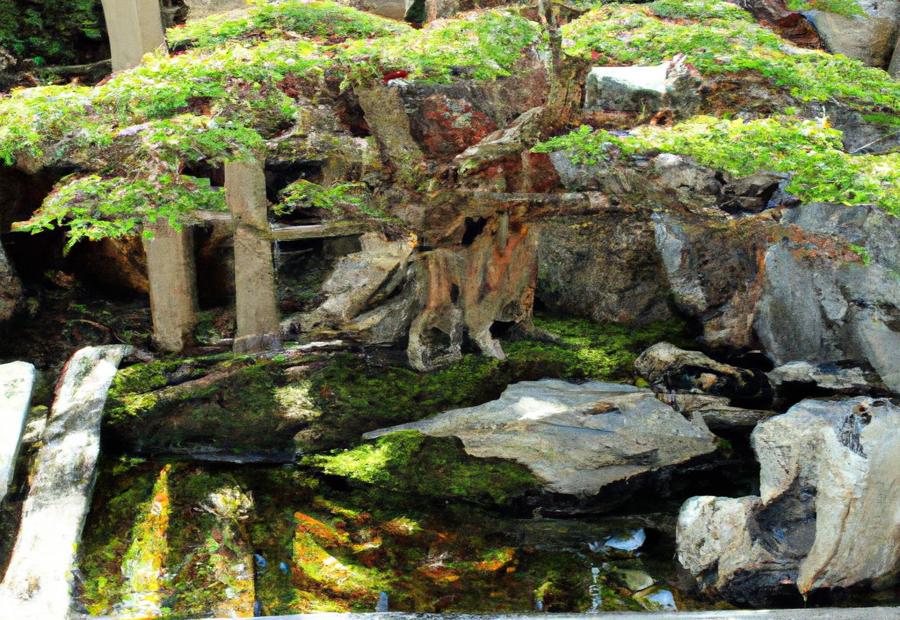
Photo Credits: Gardeninggurus.Org by Austin Miller
Enhancing the art of bonsai landscaping goes beyond just cultivating the trees themselves. In this section, we will explore the various ways to elevate the beauty of bonsai gardens. From adding water features and lighting to considering outdoor furniture for a peaceful oasis, displaying significant trees on poles for better visibility, and experimenting with different arrangements and styles, we will uncover the endless possibilities that can transform a bonsai garden into a captivating masterpiece.
Adding additional elements like water features and lighting
Water features and lighting can bring beauty and elegance to bonsai landscaping. Ponds, fountains, and cascades can give a tranquil atmosphere and provide natural humidity for trees. Strategically-placed lighting can highlight individual trees or create dramatic effects at night.
These elements can create endless possibilities for creativity and design. They can make a bonsai garden an oasis-like environment that showcases the trees’ beauty and serenity. A soothing fountain among manicured trees or spotlights on delicate branches can make a captivating experience.
Considering outdoor furniture for a peaceful oasis
Outdoor furniture for a bonsai garden? A great idea! It’ll create a tranquil oasis. Place seating and tables strategically for visitors to appreciate the trees. This not only boosts the overall garden experience, but also welcomes people to connect with nature.
Benefits of outdoor furniture in a peaceful oasis? An inviting place for visitors to rest and observe beauty. Enjoying quiet moments or hosting gatherings with friends? All possible with the right outdoor furniture. Layer tranquility to your bonsai garden, making it a place of solace and renewal.
Displaying significant trees on poles for better visibility
Incorporate the keywords “displaying significant trees on poles” into your garden design for better visibility and practical benefits. Elevating these trees increases their visibility from a distance and provides up-close views for those interested. This adds a sense of drama, grandeur, and depth to the overall design.
The poles used can be wood, metal, or bamboo; chosen based on compatibility and aesthetics. Make sure to select poles that are thick enough to support the weight of each tree.
Not only does this technique enhance visibility, it also adds artistry and sophistication. It showcases the beauty and uniqueness of each tree while creating an eye-catching feature.
Branch out and explore the world of bonsai landscaping! Get creative with arrangements and styles.
Experimenting with different arrangements and styles
Select a selection of bonsai trees of various shapes, sizes, and foliage colors to make your garden diverse. Consider the balance between the trees and other elements, like rocks or water features. Try out different combinations to find a harmonious arrangement that flatters the landscape.
Explore container options for displaying the bonsai trees. Experiment with materials, sizes, and colors to see which best highlight each tree’s beauty. In addition, consider positioning techniques, like placing trees at different heights or angles, to create visual interest. Mix up groupings or solitary displays to make your garden unique.
Don’t be afraid to be creative in your bonsai garden design! There are established guidelines, like formal upright or cascade, but there is room for innovation and personal expression. Experiment with different arrangements and styles, allowing your garden to reflect your individual style without sacrificing tradition or harmony.
Bonsai gardens: Where trees reach new heights and humor takes root.
Conclusion
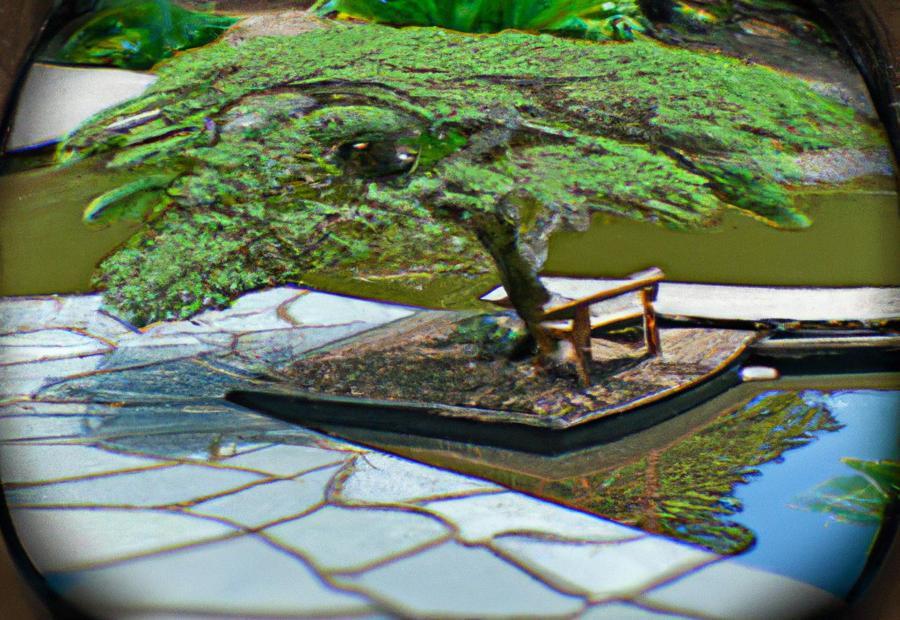
Photo Credits: Gardeninggurus.Org by Elijah Allen
In the conclusion, we recap the significance and allure of bonsai gardens, and provide you with final tips on designing and maintaining your own serene bonsai paradise.
Recap of the importance and beauty of bonsai gardens
Bonsai gardens boast unparalleled beauty and are of significant importance. They need to be attended to and maintained for them to prosper. Design factors are essential for a well-crafted bonsai garden, including shade-cloth systems for varying shadows and placing important trees on poles. The selection of species and styling also makes a vital contribution to the garden’s aesthetics.
Light, watering, repotting and shaping are indispensable for keeping bonsai healthy. Pruning and limiting branches let more light penetrate, and balanced fertilizer gives them proper nutrition. Placing bonsai in landscape design raises the atmosphere, with decorative elements such as rocks and water features accentuating their natural beauty.
Further enhancements to bonsai landscaping can be made with elements like water features and lighting. Outdoor furniture creates a peaceful setting to enjoy the serenity of bonsai gardens. Displaying important trees on poles makes them more visible, and trying out different arrangements adds a special touch to the design.
To conclude, bonsai gardens are remarkable for their beauty and importance. They require delicate care and maintenance, utilizing design aspects such as shade-cloth systems and poles for tree display. Species and styling choice boosts the aesthetics, and proper care techniques sustain their health. Additional components such as water features and lighting augment the landscaping, transforming it into a tranquil oasis to relish the beauty of bonsai gardens.
Final tips for successful bonsai garden design and maintenance
Bonsai garden design and maintenance requires one to be attentive to many factors. So, pick bonsai species that are suitable for your climate and learn about bonsai styles. Additionally, proper maintenance is key – light, water, fertilization, pruning, and repotting – for the health and longevity of bonsai trees.
For a unique look, add extras like rocks and water features to the landscape. Consider outdoor furniture to create a peaceful atmosphere. And, display significant trees on poles for visibility.
Monitor the health of your trees routinely, checking for any signs of disease or pests. Ensure enough sunlight reaches them all by trimming and limiting branches. Balance fertilizer according to the needs of each tree for healthy development.
Finally, for successful bonsai garden design and maintenance, remember to:
- Choose bonsai species suitable for your climate
- Understand different bonsai styles
- Maintain proper light, watering, and fertilization
- Regularly prune and shape the bonsai trees
- Stay aware of repotting needs
Some Facts About Bonsai Garden Design:
- ✅ Designing a well-designed Bonsai garden is challenging as it requires displaying trees at eye-level and considering individual tree requirements. (Source: Team Research)
- ✅ Professional Bonsai gardens often use shade-cloth systems to provide varying amounts of shadow for trees that need partial shade. (Source: Team Research)
- ✅ Displaying important trees on vertical poles in the garden is common in Japanese Bonsai gardens. (Source: Team Research)
- ✅ Wooden pillars, stone slabs, and concrete pillars are commonly used materials for the poles. (Source: Team Research)
- ✅ Building a bench for Bonsai trees is more difficult than it seems, and durability is a key factor. (Source: Team Research)
FAQs about Bonsai Garden Design
How do I design a well-designed Bonsai garden that meets the individual requirements of each tree?
Designing a well-designed Bonsai garden can be challenging as it requires displaying trees at eye-level and considering the unique needs of each tree. Some key considerations include using shade-cloth systems for trees that need partial shade, displaying important trees on vertical poles using materials like wooden pillars, stone slabs, or concrete pillars, and building durable benches. Inspiration and guidelines for designing a Bonsai garden can be found in various resources.
What are the key elements of a Bonsai garden?
A Bonsai garden typically includes trees at eye level, shade-cloth systems, wooden poles, stone slabs, concrete pillars, and benches. The designs often incorporate minimalism and elements like rocks and stones for a natural and tranquil feel. Careful attention is given to providing sufficient light and watering, as well as shaping and pruning the trees. The suitable species for a Bonsai garden may include mountain pine, Norway spruce, juniper, cypress, apple, plum, cherry, chestnut, linden, oak, willow, and birch trees.
What materials do I need for landscaping with Bonsai trees?
Landscaping with Bonsai trees requires various materials, including bonsai trees themselves, bonsai pots, bonsai potting soil, aggregates for drainage, rocks for decoration, balanced fertilizer, water, wire for shaping, pliers, and pruning shears. These materials are essential for shaping and maintaining the trees and creating a visually appealing landscape design.
What are the different bonsai styles that can be used in a garden?
Bonsai trees can be styled in various ways to create different effects. Some popular bonsai styles include the slanted trunk (shakan-style), curved S-shaped trunk (moyogi-style), straight upward trunk with balanced branches (chokkan-style), curved downhill (kengai-style), and molded by winds (fukinagashi-style). The choice of bonsai style depends on personal preference and the overall landscape design.
What maintenance tasks are required for bonsai plants?
Maintenance for bonsai plants includes regular pruning, trimming, and pinching to maintain their desired shapes. Proper watering and feeding according to the tree’s requirements are crucial for their health. Additionally, wiring can be used to regulate growth and shape the tree. It is also important to choose trees that match the overall garden design, keep an eye on their health, and provide appropriate care.
What are some sources for inspiration and ideas for bonsai garden design?
There are various sources for bonsai garden design inspiration and ideas. You can explore resources like books, blogs, websites, and social media platforms, where you can find images, videos, and articles showcasing different bonsai gardens, tree varieties, and landscaping techniques. Additionally, professional bonsai gardens and museums often exhibit beautiful examples of bonsai trees and garden designs, providing further inspiration.


